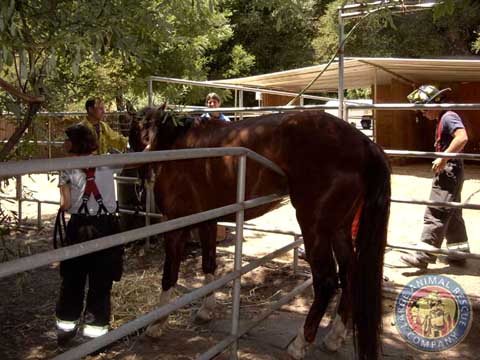
Horses, ponies, cows, llamas, large dogs often get in trouble and knowing how to safely catch, hold and save them is very important. I recently blogged about such a rescue – you can see it by clicking HERE
Humane societies, vets and concerned horse owners have been learning things mostly on a word-of-mouth basis for years.

 Now for the first time there is an organization solely dedicated to teaching others how to do large animal rescues (LAR). It’s called, not suprisingly, the Large Animal Rescue Organization and is located in Hollister, California. It was started and is run by John and Deb Fox. Great people. Please encourage your local fire department to contact them and learn more about the training program.
Now for the first time there is an organization solely dedicated to teaching others how to do large animal rescues (LAR). It’s called, not suprisingly, the Large Animal Rescue Organization and is located in Hollister, California. It was started and is run by John and Deb Fox. Great people. Please encourage your local fire department to contact them and learn more about the training program.
 You can go to their website to learn more by clicking HERE.
You can go to their website to learn more by clicking HERE.
From their website:
“The Fire Service Charter calls for the protection of life, property and the environment. Horses have long been a part of the American landscape. As utilitarian livestock, or property, they fought wars, broke turf, cleared forests, were a mode of transportation, and pulled fire steamers. Their ability to quickly pull thousands of pounds of equipment to the fire ground was a turning point in firefighting. This meant that firefighters could save their energy for fighting the fire. More importantly it enabled faster knockdown and containment of the fire for a higher success rate. The fact that these horses, fearful of fire by nature, were willing to fight their instincts to do their job is a tribute to their ability to form a team relationship and put trust in a human being.
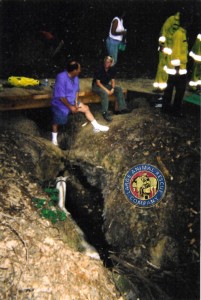 “In the 1900’s, the automobile gradually replaced the horse. However, horses remained a commodity with the racing industry. The legendary Seabiscuit had lifetime earnings of $437,730 over a period of 5 years from 1935 to 1940. Horses continue to represent a substantial source of income and entertainment not only in racing, but also in related industries such as rodeos and horse shows. These events are held nationwide, enjoyed by millions and provide a livelihood for thousands.
“In the 1900’s, the automobile gradually replaced the horse. However, horses remained a commodity with the racing industry. The legendary Seabiscuit had lifetime earnings of $437,730 over a period of 5 years from 1935 to 1940. Horses continue to represent a substantial source of income and entertainment not only in racing, but also in related industries such as rodeos and horse shows. These events are held nationwide, enjoyed by millions and provide a livelihood for thousands.
“There is currently in excess of 10.31 million horses in the United States. A whole new breed of horse owner actively participates in endurance races, horse shows, and recreational riding investing thousands of dollars in horses that may be worth well into six figures. Every year, there are more trailers on roadways as riders haul their horse to events and to ride the trails in national, state and county parks.
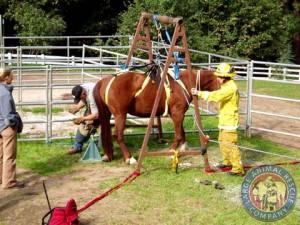 “Horses are now regarded by many as not just an investment or commodity, but as a working partners and companions. This feeling was reinforced a few years ago when the state of California changed the status of horses from livestock to companion animals. For some, they are active members of the family. The loss of a family dog or cat can be devastating to a family that has shared a bond of six to 16 years. Some families have had a horse for 20 – 30 years. To the little girl that got her first horse when she was ten and maintained that friendship through all the turbulent years into adulthood, the worth of the animal is immeasurable. To these people, horses represent life and should be protected under the Fire Service Charter.
“Horses are now regarded by many as not just an investment or commodity, but as a working partners and companions. This feeling was reinforced a few years ago when the state of California changed the status of horses from livestock to companion animals. For some, they are active members of the family. The loss of a family dog or cat can be devastating to a family that has shared a bond of six to 16 years. Some families have had a horse for 20 – 30 years. To the little girl that got her first horse when she was ten and maintained that friendship through all the turbulent years into adulthood, the worth of the animal is immeasurable. To these people, horses represent life and should be protected under the Fire Service Charter.
“The attitude of the general public towards animals has changed from the days when the only answer was the “silver bullet”. Recognizing the value of life, and the professionalism of emergency responders, the general public has an expectation that an honest effort will be made to save an animal if at all possible.
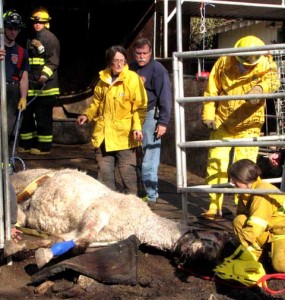 “It is the domain of Animal Care and Control agencies to resolve LAR incidents. Unfortunately these agencies can be easily overwhelmed by the complexities of a LAR. As a primary resource for TLAR, the Fire Service can work together with Animal Care and Control agencies to provide sufficient staffing, equipment, and technical skills. The technical skills introduced to firefighters in Fire Fighter 1 Academy can be used to resolve a LAR when applied with an understanding of horse characteristics and behavior. It is critical for the large animal veterinarian to guide the efforts of these responders with medical authority. Law enforcement may also be called upon to manage spectators or control traffic. Often first on scene, an informed law enforcement officer can request the proper resources, saving valuable time. In the event of an on-road incident or an incident that happens in a county, state or national park, law enforcement, including park rangers, will have jurisdiction.
“It is the domain of Animal Care and Control agencies to resolve LAR incidents. Unfortunately these agencies can be easily overwhelmed by the complexities of a LAR. As a primary resource for TLAR, the Fire Service can work together with Animal Care and Control agencies to provide sufficient staffing, equipment, and technical skills. The technical skills introduced to firefighters in Fire Fighter 1 Academy can be used to resolve a LAR when applied with an understanding of horse characteristics and behavior. It is critical for the large animal veterinarian to guide the efforts of these responders with medical authority. Law enforcement may also be called upon to manage spectators or control traffic. Often first on scene, an informed law enforcement officer can request the proper resources, saving valuable time. In the event of an on-road incident or an incident that happens in a county, state or national park, law enforcement, including park rangers, will have jurisdiction.
“The Standardized Emergency Management System (SEMS) can be used to coordinate responding agencies under a “Unified Command.” This command must be shared with the owner who carries financial responsibility and has ultimate authority over the fate of the animal. In lieu of the owner, who may be absent, injured, or traumatized, the animal service agency must assume responsibility for the animal during and after the rescue. These agencies must work “in concert” with each other to set common goals, devise tactics, and achieve a successful rescue.
“As the primary resource for LAR, the fire service offers staffing and the ability to get more staffing as needed. They have radio communication for on-scene management and are accustomed to working in a team situation. Generators on rescue trucks can provide on-scene lighting for nighttime responses. Rope systems can be employed to haul, lift or lower animals. If heavy equipment or a helicopter is necessary, the fire department has the ability to obtain it. The fire department is also experienced with the set up and management of helicopter landing zones. Jaws, air bags, and other vehicle extrication equipment can be used to free a horse from a wrecked trailer or barn collapse. Standard medical bags have the equipment to monitor the animal’s vital signs and dispense oxygen until the veterinarian arrives on-scene. The fire department can also be a repository for specialized LAR appliances that make rescue easier. In lieu of these devices, equipment standard to any fire engine can be adapted for LAR.
“Santa Cruz County, California has recognized the merit of a multi-agency response to LAR. With one phone call to 911, the fire department, large animal veterinarian, animal control services and if necessary law enforcement are summoned to help the animal in distress. With training, these agencies, including the owner, have learned to work together, each contributing their respective skills and experience. This program has led to the efficient and effective resolution of LAR incidents, both emergency and non-emergency public service calls, for six years now.
“The California State Fire Marshall has approved and adopted the training necessary for LAR response through the Fire Services Training and Education Program (FSTEP). Large Animal Rescue – Operational, a one day class, gets all of the agencies working off of the same page by teaching respective roles, principals of rescue, application of technique and equipment, and most importantly, safety. Firefighters can learn how to stay safe on-scene and not pose a danger to others through inappropriate behavior.
“Imagine a rider trapped beneath an injured horse. Imagine a human attendant stranded in the stock compartment of a rolled horse transport, or a rolled stock trailer impacting traffic for miles. These are examples of LAR incidents where the fire department will be called. A relatively small amount of training can prepare firefighters for these events and enable them to fulfill the Fire Service Charter with humanitarian service.
Why we formed
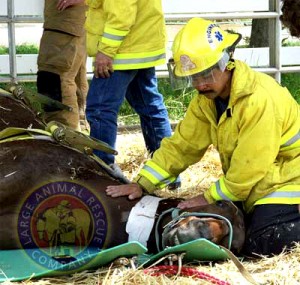 “Over the years we noticed that with the growing interface between rural and urban environments, there has been an increase in the number of incidents involving horses and other large animals. Determined to train our department in how to handle the incidents in our district, we looked all over the country and all over the world for training. The culmination of this search resulted in LAR curriculum development that was ultimately approved and adopted by the California State Fire Marshall’s STEAC committee and California’s POST (Peace Officer’s Standards and Training).
“Over the years we noticed that with the growing interface between rural and urban environments, there has been an increase in the number of incidents involving horses and other large animals. Determined to train our department in how to handle the incidents in our district, we looked all over the country and all over the world for training. The culmination of this search resulted in LAR curriculum development that was ultimately approved and adopted by the California State Fire Marshall’s STEAC committee and California’s POST (Peace Officer’s Standards and Training).
Our Effort is built on the efforts of others
“The excellent programs for Large Animal response in such countries as the United Kingdom and Sweden offered inspiration that LAR could become a standardized response in this country. We are indebted to Assistant Divisional Officer Roy Earl, MIFireE of the Hampshire Fire and Rescue Service for his generosity in providing material from the East Sussix Fire Brigade Operations Manual on Animal Rescues and Sparsholt College Hampshire’s course description of the Animal Handling & Awareness Course for Hampshire’s Fire Brigade.
“After adapting this material to our own environment, we supplemented it with the expertise of Tomas Gimenez, MVZ, Dr,Med. Vet. of Clemson University and Rebecca Gimenez, PhD. Of Anderson College. Tomas and Rebecca monitored the veterinary medical aspect of TLAR. Their contributions on prey animal characteristics influenced our protocols for LAR scene management and operations. Their development of a 2-strap appliance offers a practical method for short vertical lifts that represents a notable contribution to LAR. Hundreds of students have had the opportunity to receive valuable hands-on experience with live animals used in their training program through Clemson University.
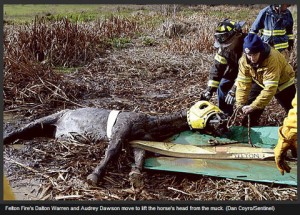 “Timothy Collins of Santa Barbara gave us our working knowledge of LAR. He introduced us to the versatility of his rescue strap and taught us the basics of LAR. The work of Dr. Stephen Dey on trailer accidents and extrication formed a valuable foundation for our component on On-Road Incidents. Dr. Dey’s description of the vertical lift tie has provided us with a practical means of lifting animal for remote rescues. Dr. Robert Miller’s articles on horse behavior have impacted every aspect of our LAR response. Our own behavior and operations are dictated by an understanding of these prey animals and what motivates them. Charles Anderson introduced us to specialized LAR equipment, the Anderson sling and the Rescue Glide. Charlie is a leader in the development of equipment for the rescue and assistance of disabled animals.
“Timothy Collins of Santa Barbara gave us our working knowledge of LAR. He introduced us to the versatility of his rescue strap and taught us the basics of LAR. The work of Dr. Stephen Dey on trailer accidents and extrication formed a valuable foundation for our component on On-Road Incidents. Dr. Dey’s description of the vertical lift tie has provided us with a practical means of lifting animal for remote rescues. Dr. Robert Miller’s articles on horse behavior have impacted every aspect of our LAR response. Our own behavior and operations are dictated by an understanding of these prey animals and what motivates them. Charles Anderson introduced us to specialized LAR equipment, the Anderson sling and the Rescue Glide. Charlie is a leader in the development of equipment for the rescue and assistance of disabled animals.
“By combining the work of these experts with experts from the fire service, we were able to develop practical LAR techniques. We found that we could take standard equipment, available on almost every fire engine in the country, and adapt it to LAR incidents. Now, with training, any rescue or engine company can mitigate a LAR incident successfully.”
